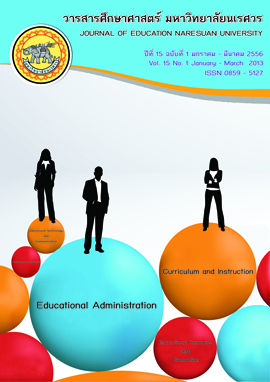การพัฒนาหลักสูตรบรรณาธิการเพื่อเสริมสร้างความรู้และความสามารถในการตรวจหนังสือเรียนอย่างมีวิจารณญาณตามแนวคิดของเอนนิส
Main Article Content
Abstract
บทคัดย่อ
การวิจัยครั้งนี้มีวัตถุประสงค์เพื่อพัฒนาหลักสูตรบรรณาธิการเพื่อเสริมสร้างความรู้และความสามารถในการตรวจหนังสือเรียนอย่างมีวิจารณญาณตามแนวคิดของเอนนิส และเพื่อประเมินประสิทธิภาพของหลักสูตรที่พัฒนาขึ้น การดำเนินการวิจัยแบ่งออกเป็น 2 ระยะ คือ ระยะที่ 1 การพัฒนาหลักสูตรที่สอดคล้องกับปัญหาในสภาพจริง และระยะที่ 2 การประเมินประสิทธิภาพของหลักสูตรโดยนำไปทดลองกับกลุ่มตัวอย่างซึ่งเป็นบรรณาธิการหนังสือเรียนจากสำนักพิมพ์ 3 แห่ง จำนวน 20 คน ใช้เวลาในการทดลอง 8 สัปดาห์ รวม 35 ชั่วโมง เครื่องมือที่ใช้ในการวิจัย ได้แก่ แบบทดสอบความรู้ในการตรวจหนังสือเรียน เกณฑ์การประเมินผลงานด้านความสามารถในการนำความรู้ใช้ในการตรวจหนังสือเรียน แบบสังเกตพฤติกรรมในการนำความรู้ใช้ในการตรวจหนังสือเรียน และเกณฑ์และมาตรฐานหนังสือเรียนที่ส่งเสริมกระบวนการคิดอย่างมีวิจารณญาณตามแนวคิดของเอนนิส วิเคราะห์ข้อมูลโดยเปรียบเทียบคะแนนความรู้และความสามารถในการตรวจหนังสือเรียน ระหว่างก่อนการทดลอง ระหว่างการทดลองและหลังการทดลองโดยใช้ค่าเฉลี่ย ส่วนเบี่ยงเบนมาตรฐาน การวิเคราะห์ความแปรปรวนทางเดียวแบบวัดซ้ำ (One-wayanalysis of variance with repeated measures) ผลการวิจัยสรุปได้ดังนี้
1. หลักสูตรที่พัฒนาขึ้นมีองค์ประกอบ 11 องค์ประกอบ คือ 1) วิสัยทัศน์ของหลักสูตร 2) เป้าหมายของหลักสูตร 3) จุดประสงค์ของหลักสูตร 4) สาระของหลักสูตร 5) คำอธิบายรายวิชา 6) หน่วยการเรียนรู้หน่วยการเรียนรู้ย่อย 7) การจัดหน่วยการเรียนรู้ 8) โครงสร้างเวลาเรียน 9) แนวการจัดกิจกรรมการเรียนรู้10) การวัดและประเมินผลการเรียนรู้ 11) แหล่งการเรียนรู้ เนื้อหาที่พัฒนาขึ้นประกอบด้วยสาระใน 4 หน่วยการเรียนรู้ คือ 1) ความรู้ความเข้าใจเกี่ยวกับเกณฑ์และมาตรฐานการตรวจประเมินสื่อ และเกณฑ์มาตรฐานหนังสือเรียนที่ส่งเสริมการคิดอย่างมีวิจารณญาณตามแนวคิดของเอนนิสในเรื่อง การระบุประเด็นปัญหา การสร้างคำถามท้าทาย การวิเคราะห์และนำเสนอข้อโต้แย้ง การสรุปโดยใช้เหตุผลเชิงอุปนัยและนิรนัย 2) การประเมินคุณค่าต้นฉบับหนังสือเรียน 3) ทักษะการตรวจหนังสือเรียนอย่างมีวิจารณญาณตามแนวคิดของเอนนิส ในฉบับจำลอง 4) ทักษะการตรวจหนังสือเรียนอย่างมีวิจารณญาณตามแนวคิดของเอนนิสในฉบับจริง
2. ผลจากการทดลองใช้หลักสูตร พบว่า
2.1 กลุ่มตัวอย่างมีคะแนนเฉลี่ยความรู้เกี่ยวกับการตรวจหนังสือเรียนสูงกว่าก่อนทดลองอย่างมนัยสำคัญทางสถิติที่ระดับ .05 ในทุกเรื่อง โดยมีความรู้เรื่องการระบุประเด็นปัญหาเพิ่มขึ้นมากที่สุดรองลงมา คือ การตั้งคำถามท้าทาย การสรุปโดยใช้เหตุผลเชิงนิรนัย การสรุปโดยใช้เหตุผลเชิงอุปนัย และการวิเคราะห์และนำเสนอข้อโต้แย้ง
2.2 กลุ่มตัวอย่างมีคะแนนเฉลี่ยความสามารถในการตรวจหนังสือเรียนสูงกว่าก่อนทดลองอย่างมีนัยสำคัญทางสถิติที่ระดับ .05 ในทุกเรื่อง โดยมีความรู้เรื่องการระบุประเด็นปัญหาเพิ่มขึ้นมากที่สุดรองลงมา คือ การตั้งคำถามท้าทาย การสรุปโดยใช้เหตุผลเชิงนิรนัย การสรุปโดยใช้เหตุผลเชิงอุปนัย และการวิเคราะห์และนำเสนอข้อโต้แย้ง
Abstract
The Purpose of this research were to develop the editorial curriculum to enhancetextbook critical editing knowledge and ability based on Ennis’ approach for enhancing textbookcritical editing knowledge and ability of editor who were trained to be the critical editors both inthe manuscript textbook critical editing knowledge and ability including the manuscriptevaluation, and evaluate the efficiency of the developed curriculum. The research procedure wasdivided into two phases; 1) development of a curriculum based on real problem; and 2)effectiveness evaluation of a curriculum through implementation with the subjects who weretwenty editors from three publishers. The duration of experiment was eight weeks with thetotal of thirty five hours. The research instruments were knowledge test, works of practicecriteria, behaviours observation and criteria of critical thinking supported textbook based onEnnis’ Approach. The data were analyzed by using mean, standard deviation and One-wayanalysis of variance with repeated measures. The finding of this study were as follow:
1. The developed consisted of 11 components; 1) the curriculum vision, 2) Aim, 3)objective, 4) content, 5) course description 6) learning unit, sub-learning unit 7) learning unitmanagement 8) structure of learning time table 9) learning process,10)learning measurement andevaluation, 11) learning resources. The developed content consists of 4 units which were 1)The knowledge of criteria of learning media and criteria of critical thinking supported textbookbased on Ennis’ Approach in focusing of question, asking of challenge question, analyzingand presentation of arguments, conclusion of induction and deduction reasons 2) evaluation oftextbook manuscript 3) textbook critical editing knowledge and ability based on Ennis’approach in pilot version 4) textbook critical editing knowledge and ability based on Ennis’approach in real textbook version.
2. The experimental result of the curriculum after experiment, it was found that;
2.1 The subjects had the average score of knowledge of textbook critical editinghigher than before the experiment at .05 level of significance in all components. The knowledgewith most significant improvement was focusing of question followed by asking of challengequestion, conclusion of induction reason, conclusion of deduction reason and analyzing andpresentation of arguments.
Keywords: The Development of Editorial Curriculum, Textbook Critical Editing Knowledge andAbility, Critical Thinking, Editor
Article Details
The owner of the article does not copy or violate any of its copyright. If any copyright infringement occurs or prosecution, in any case, the Editorial Board is not involved in all the rights to the owner of the article to be performed.


